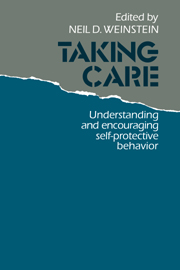Book contents
- Frontmatter
- Contents
- List of contributors
- Acknowledgments
- Introduction: studying self-protective behavior
- I Theoretical perspectives
- II Research and prevention programs for specific hazards
- 6 Why people take precautions against health risks
- 7 Community studies of smoking cessation
- 8 Preventing adolescent smoking
- 9 Natural hazards and precautionary behavior
- 10 Programs that encourage the adoption of precautions against natural hazards: review and evaluation
- 11 Why people take precautions against crime: a review of the literature on individual and collective responses to crime
- 12 Promoting citizen involvement in crime prevention and control
- 13 Injury prevention: limits to self-protective behavior
- 14 Perspectives on protective behaviors and work place hazards
- III Conclusion
- Index
10 - Programs that encourage the adoption of precautions against natural hazards: review and evaluation
Published online by Cambridge University Press: 03 February 2010
- Frontmatter
- Contents
- List of contributors
- Acknowledgments
- Introduction: studying self-protective behavior
- I Theoretical perspectives
- II Research and prevention programs for specific hazards
- 6 Why people take precautions against health risks
- 7 Community studies of smoking cessation
- 8 Preventing adolescent smoking
- 9 Natural hazards and precautionary behavior
- 10 Programs that encourage the adoption of precautions against natural hazards: review and evaluation
- 11 Why people take precautions against crime: a review of the literature on individual and collective responses to crime
- 12 Promoting citizen involvement in crime prevention and control
- 13 Injury prevention: limits to self-protective behavior
- 14 Perspectives on protective behaviors and work place hazards
- III Conclusion
- Index
Summary
Introduction
Each year natural disasters take a significant toll of life and impart enormous costs to people in the United States. Virtually everyone is at some degree of risk from climatological or geophysical events, and certainly all help to pay for some of the damage these events inflict. Thus, it is in the interest of all to attempt to prevent losses and to support programs designed to reduce losses. Despite the inherent rationality of this statement people are, in general, reluctant to act until a nearby disaster stimulates their concern or they become victimized by disaster. Losses from natural disasters fluctuate but generally continue to rise. The potential for catastrophic events and losses has increased dramatically. As a result, numerous private and public programs have been developed to stimulate preparedness for disaster and to encourage the adoption of risk-reducing and protective actions.
One of the purposes of this chapter is to review attempts to encourage the adoption of actions that increase protection against natural hazards and disasters. In addition, examples of specific programs designed to influence human behavior and response to natural hazards are described. Special attention is given to methods of providing the public with information and to some of the educational programs developed to do so. The chapter also reviews the rather limited attempts that have been made to evaluate the programs discussed here. It concludes with a discussion of the success and failure of these programs.
- Type
- Chapter
- Information
- Taking CareUnderstanding and Encouraging Self-Protective Behavior, pp. 208 - 230Publisher: Cambridge University PressPrint publication year: 1987
- 13
- Cited by



